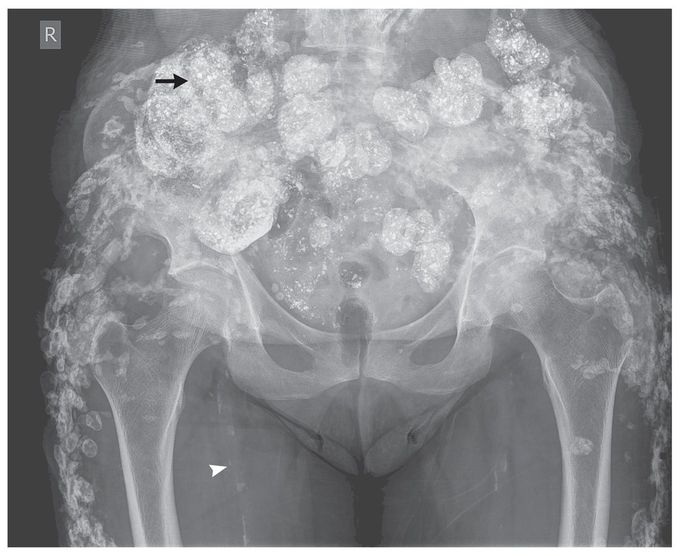


Metastatic Calcification and Long-Term Hemodialysis
An 80-year-old woman presented with left leg pain. She had end-stage renal disease caused by hypertensive nephrosclerosis and was undergoing maintenance hemodialysis. A radiograph of the pelvis and femur revealed extensive calcifications (arrow) in the muscles and subcutaneous tissues of the lower abdominal wall, gluteal regions, and outer thighs, in addition to vascular calcification (arrowhead) and osteopenia. There was no evidence of fracture. The patient was receiving warfarin because of atrial fibrillation. She also had secondary hyperparathyroidism due to renal failure; a month before the administration of cinacalcet was begun, she had a parathyroid hormone level of 73.1 pmol per liter (normal range, 0.8 to 5.5) and a product of the calcium level times the phosphorus level of 5.2 mmol2 per square liter (65 mg2 per square deciliter; reference range, <4.4 mmol2 per square liter [<55 mg2 per square deciliter]). Secondary hyperparathyroidism, a high calcium–phosphorus product, and warfarin have been associated with metastatic calcification and calcific uremic arteriolopathy (calciphylaxis), especially in patients undergoing dialysis. Warfarin inhibits γ-carboxylation of matrix Gla protein (a protein that inhibits calcification). The administration of warfarin was stopped, and aggressive management of calcium and phosphorus levels was continued. Although the biochemical variables improved, the patient continues to have pain, which is a notable feature of calcific uremic arteriolopathy. Attempts to manage her pain continue.

